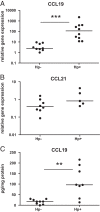DC-LAMP+ dendritic cells are recruited to gastric lymphoid follicles in Helicobacter pylori-infected individuals
- PMID: 23876802
- PMCID: PMC3811775
- DOI: 10.1128/IAI.00801-13
DC-LAMP+ dendritic cells are recruited to gastric lymphoid follicles in Helicobacter pylori-infected individuals
Abstract
Infection with Helicobacter pylori is associated with development of ulcer disease and gastrointestinal adenocarcinoma. The infection leads to a large infiltration of immune cells and the formation of organized lymphoid follicles in the human gastric mucosa. Still, the immune system fails to eradicate the bacteria, and the substantial regulatory T cell (Treg) response elicited is probably a major factor permitting bacterial persistence. Dendritic cells (DCs) are professional antigen-presenting cells that can activate naive T cells, and maturation of DCs is crucial for the initiation of primary immune responses. The aim of this study was to investigate the presence and localization of mature human DCs in H. pylori-infected gastric mucosa. Gastric antral biopsy specimens were collected from patients with H. pylori-associated gastritis and healthy volunteers, and antrum tissue was collected from patients undergoing gastric resection. Immunohistochemistry and flow cytometry showed that DCs expressing the maturation marker dendritic cell lysosome-associated membrane glycoprotein (DC-LAMP; CD208) are enriched in the H. pylori-infected gastric mucosa and that these DCs are specifically localized within or close to lymphoid follicles. Gastric DC-LAMP-positive (DC-LAMP(+)) DCs express CD11c and high levels of HLA-DR but little CD80, CD83, and CD86. Furthermore, immunofluorescence analyses demonstrated that DC-LAMP(+) DCs are in the same location as FoxP3-positive putative Tregs in the follicles. In conclusion, we show that DC-LAMP(+) DCs with low costimulatory capacity accumulate in the lymphoid follicles in human H. pylori-infected gastric tissue, and our results suggest that Treg-DC interactions may promote chronic infection by rendering gastric DCs tolerogenic.
Figures




Similar articles
-
Involvement of myeloid dendritic cells in the development of gastric secondary lymphoid follicles in Helicobacter pylori-infected neonatally thymectomized BALB/c mice.Infect Immun. 2003 Apr;71(4):2153-62. doi: 10.1128/IAI.71.4.2153-2162.2003. Infect Immun. 2003. PMID: 12654837 Free PMC article.
-
Programmed Death Ligand 1-Expressing Classical Dendritic Cells MitigateHelicobacter-Induced Gastritis.Cell Mol Gastroenterol Hepatol. 2021;12(2):715-739. doi: 10.1016/j.jcmgh.2021.04.007. Epub 2021 Apr 21. Cell Mol Gastroenterol Hepatol. 2021. PMID: 33894424 Free PMC article.
-
Helicobacter pylori promotes the production of thymic stromal lymphopoietin by gastric epithelial cells and induces dendritic cell-mediated inflammatory Th2 responses.Infect Immun. 2010 Jan;78(1):108-14. doi: 10.1128/IAI.00762-09. Epub 2009 Oct 19. Infect Immun. 2010. PMID: 19841072 Free PMC article.
-
Dendritic cell function in the host response to Helicobacter pylori infection of the gastric mucosa.Pathog Dis. 2013 Feb;67(1):46-53. doi: 10.1111/2049-632X.12014. Epub 2013 Jan 22. Pathog Dis. 2013. PMID: 23620119 Review.
-
Role of Regulatory T-cells in Different Clinical Expressions of Helicobacter pylori Infection.Arch Med Res. 2016 May;47(4):245-54. doi: 10.1016/j.arcmed.2016.07.013. Arch Med Res. 2016. PMID: 27664483 Review.
Cited by
-
Role of Gastric Microorganisms Other than Helicobacter pylori in the Development and Treatment of Gastric Diseases.Biomed Res Int. 2022 Mar 14;2022:6263423. doi: 10.1155/2022/6263423. eCollection 2022. Biomed Res Int. 2022. PMID: 35321071 Free PMC article. Review.
-
Relationship between Helicobacter pylori Infection and Plasmacytoid and Myeloid Dendritic Cells in Peripheral Blood and Gastric Mucosa of Children.Mediators Inflamm. 2019 Nov 11;2019:7190596. doi: 10.1155/2019/7190596. eCollection 2019. Mediators Inflamm. 2019. PMID: 31827378 Free PMC article.
-
Novel insights on the role of CD8+ T cells and cytotoxic responses during Helicobacter pylori infection.Gut Microbes. 2014 May-Jun;5(3):357-62. doi: 10.4161/gmic.28899. Epub 2014 Apr 22. Gut Microbes. 2014. PMID: 24755940 Free PMC article. Review.
-
The Role of Gastric Mucosal Immunity in Gastric Diseases.J Immunol Res. 2020 Jul 24;2020:7927054. doi: 10.1155/2020/7927054. eCollection 2020. J Immunol Res. 2020. PMID: 32775468 Free PMC article. Review.
References
-
- Fischbach W, Chan AO, Wong BC. 2005. Helicobacter pylori and gastric malignancy. Helicobacter 10(Suppl 1):34–39 - PubMed
-
- Huang JQ, Sridhar S, Hunt RH. 2002. Role of Helicobacter pylori infection and non-steroidal anti-inflammatory drugs in peptic-ulcer disease: a meta-analysis. Lancet 359:14–22 - PubMed
-
- Makola D, Peura DA, Crowe SE. 2007. Helicobacter pylori infection and related gastrointestinal diseases. J. Clin. Gastroenterol. 41:548–558 - PubMed
-
- Figueiredo C, Machado JC, Yamaoka Y. 2005. Pathogenesis of Helicobacter pylori infection. Helicobacter 10(Suppl 1):14–20 - PubMed
-
- Del Giudice G, Michetti P. 2004. Inflammation, immunity and vaccines for Helicobacter pylori. Helicobacter 9(Suppl 1):23–28 - PubMed
Publication types
MeSH terms
Substances
LinkOut - more resources
Full Text Sources
Other Literature Sources
Medical
Research Materials

